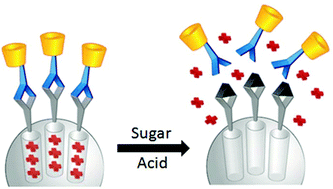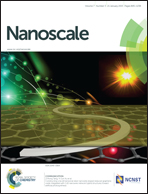Sugar and pH dual-responsive mesoporous silica nanocontainers based on competitive binding mechanisms†
Abstract
A sugar and pH dual-responsive controlled release system, which is highly specific towards molecular stimuli, has been developed based on the binding between catechol and boronic acid on a platform of mesoporous silica nanoparticles (MSNs). By grafting phenylboronic acid stalks onto the silica surface, catechol-containing β-cyclodextrins can be attached to the orifices of the MSNs’ nanopores through formation of boronate esters which block access to the nanopores. These esters are stable enough to prevent cargo molecules from escaping. The boronate esters disassociate in the presence of sugars, enabling the molecule-specific controlled-release feature of this hybrid system. The rate of release has been found to be tunable by varying both the structures and the concentrations of sugars, as a result of the competitive binding nature associated with the mechanism of its operation. Acidification also induces the release of cargo molecules. Further investigations show that the presence of both a low pH and sugar molecules provides cooperative effects which together control the rate of release.


 Please wait while we load your content...
Please wait while we load your content...